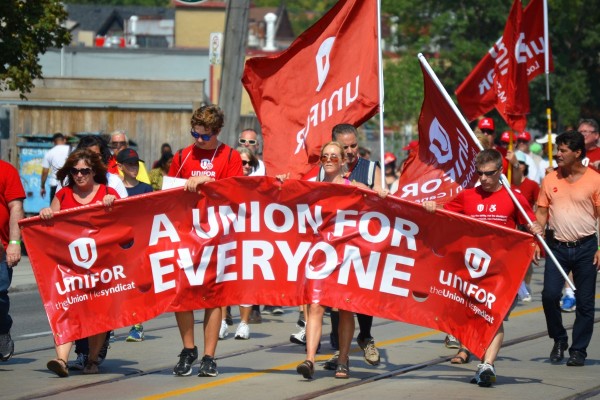Bob Rae’s NDP and the fight to pass an anti-scab law
Ontario’s first and only NDP government tabled and passed a scab-labour ban back in 1992. It was repealed by Mike Harris in 1995

Bob Rae in 1990. Photo by Ron Bull/Toronto Star.
The following is an excerpt from The Left in Power: Bob Rae’s NDP and the Working Class by Concordia University professor Steven High. Based on extensive archival research and interviews with NDP politicians, senior economic policy advisors, and trade unionists, the book revisits the heartbreaking years of Bob Rae’s Ontario NDP government—from their historic and unexpected 1990 victory, to their policy shifts that left working class voters feeling betrayed, to their landslide defeat in 1995—to uncover what we can learn from one social democratic party’s mistakes about how to govern from the left. For more information, visit www.btlbooks.com.
There was no question that substantial changes to the Ontario Labour Relations Act, making unionization easier and prohibiting the use of replacement workers during strikes, were the overriding priority of the Ontario Federation of Labour. Plant closings and layoffs were decimating private-sector unions, threatening their institutional survival. Between 1979 and 1985, for example, North American membership in the United Auto Workers, United Steelworkers of America, and United Rubber Workers fell 32.6 percent, 40.6 percent, and 32.9 percent, respectively. Hundreds of union locals were merged or rendered defunct. Trade unions also had to lay off staff members, given the contraction in membership.
The NDP government’s inaugural throne speech promised comprehensive labour law reform, as had the election manifesto. To that end, in March 1991, Bob Mackenzie, the Minister for Labour, as he liked to say, initiated a social bargaining process between two parallel teams of management and union labour lawyers with a neutral chairperson. In theory, “rather than being dictated by government, the new legislation would reflect a consensus between the private sector actors.” But the process quickly broke down. According to insiders Chuck Rachlis and David Wolfe, “the union lawyers drafted an enormous wish list of reforms that proposed to rectify through legislation every arbitration case they had lost in the past decade and the management team called for no change at all.” To make matters worse, the labour side’s maximalist proposal was leaked to the press, sparking a media firestorm and a ferocious business backlash. One of Rae’s advisors recalls how politically damaging the leak was to the government: “I mean, it was just infuriating. It was just a wish list, there was no filter on it. And it was very hurtful.” No fewer than three business coalitions formed to fight labour law reform. The ensuing fight was long and ugly.
Despite this debacle, the idea of social bargaining continued to blossom within government circles. Peter Warrian and John O’Grady, two of its most knowledgeable advocates, recommended that the government require employers to formulate and implement, jointly with labour, social plans for human resource development and labour adjustment. These social plans would then be enforced by the Ontario Labour Relations Board (OLRB). They argued that the government’s initial focus on the Employment Standards Act was a “clumsy instrument for dealing with human capital issues and with many aspects of labour adjustment.” Warrian and O’Grady recommended, instead, the extension of the duty to bargain to plant closures and layoffs, as well as the requirement that labour and management consult regularly during the life of the collective agreement. These two changes, they hoped, would provide the basis for a more collaborative and less confrontational labour relations regime in the province.

Informed by these internal discussions, Bob Mackenzie prepared a submission to cabinet with 61 proposed changes. These ranged from barring scabs to encouraging sectoral bargaining. The proposals, if adopted, would have made union recognition, the conclusion of the first contract, and the organization of smaller shops considerably easier for trade unions. The proposed legislation would also require companies to negotiate plant closing agreements, extending the duty to bargain.
There was considerable internal debate over labour law reform within cabinet, including resistance to the anti-scab provision. Wolfe remembers “sitting through a lot of P&P [Priorities and Planning] committee meetings debating the strikebreaker stuff.” Warrian, the government’s chief economist, concurs, saying it was “far from unanimous. But Rae was behind it, you know. Being premier’s not easy… you have to decide what are you going to put your weight behind, and he was behind this one.”
The Ministry of Labour then prepared a discussion paper, a draft of which was, once again, leaked in September 1991, causing more uproar. The finished draft was only released two months later, minus several contentious features such as sectoral bargaining. Even the anti-scab law was watered down. Naively, the government sought to forge a consensus, arguing that the changes would provide stability and an environment more conducive to labour-management partnership.
Business opposition remained fierce. Hundreds of newspaper articles pounded the government. Predictably, business mogul Conrad Black, later jailed for mail fraud and obstruction of justice, blasted the “innumerate Luddite biases of the NDP” and Rae’s “submissive bondage to Bob White.”
Alan Ernst, who calls himself “more of a Rosencrantz and Guildenstern type figure” insofar as he “wasn’t really in the front of the room and where the decisions were [made],” remembers that the NDP got “the crap kicked out of us” and the Minister of Labour was being pushed by the government’s “centre” to dilute the legislation further. Ernst remembers once sitting at a table alongside Mackenzie, who sat right across from a bunch of business representatives who “were literally shouting in his face. And I thought, Mackenzie twenty years ago would have gotten out of the seat and punched the guy out. And I don’t know how he could just sit there. How is he doing this with a poker face? But that was the tone. The tone was horrific.”
The union movement was taken aback by the ferocity of the business backlash. Incoming Canadian Labour Congress President Bob White called the business reaction to labour law reform “the worst kind of insanity I’ve seen in 30 years. It made them look as if they had just come out of the caves.” He didn’t think the legislation was revolutionary at all. “If I had been Bob Rae,” White mused, “I would have had a much tougher labour reform bill and I would have done it in the first couple of months. I think the government made a mistake in allowing wide consultation, but it wanted to be fair.”
For his part, Leo Gerard of the United Steelworkers of America expressed his dismay “at the level of attack on the trade union movement itself and the concept of unionization by the business community.” He reminded opponents that it took 12 to 18 months for workers to gain union certification and almost as long to get their first contract: “Workers have to sneak around in back alleys and washrooms in the dark of night to sign a card to join a union, which is recognized as an expression of democracy, for fear of getting fired, harassed and punished. Don’t talk to me about tipping the balance of power, please.”
More concessions to the proposal’s critics followed the three month-long consultation period, before the Labour Relations and Employment Statute Law Amendment (Bill 40) was finally adopted in November 1992, two years after it appeared in the NDP’s first throne speech. Frankly, these delays were a gift to the opposition parties and the business lobby.
Looking back 30 years later, John O’Grady laments the bounded horizons of the labour reform proposals. From his perspective, the pro-union labour lawyers who drafted the NDP legislation had a narrow view: “Most of them, this is the only labour relations system that they can imagine. It’s like they’ve never travelled. They don’t know that the only two places, well, three places in the world that have it like this [were] Canada, the United States, and the Philippines. Nobody else does it this way.” The government’s willingness to drop the sectoral bargaining component particularly hurt. It was considered “too novel” within the North American context, he laments: “Labour lawyers couldn’t understand it.” Peter Warrian agrees, suggesting sectoral bargaining would have been a game changer, as smaller workshops would have become organized. O’Grady adds that the mainstream trade union movement was, itself, “deeply conservative” with respect to labour relations reform: “They don’t actually want it reformed. They want it tinkered with.”
Albeit watered down, Ontario’s labour law reforms made some difference for unions. But it was not the tipping point that proponents of sectoral bargaining had hoped for. In any case, the labour reforms were quickly rolled back by the Tories in 1995, and the window to organize the unorganized was quickly slammed shut.
Steven High is a professor of history at Concordia University. His new book, The Left in Power: Bob Rae’s NDP and the Working Class (Between the Lines) is available now.










